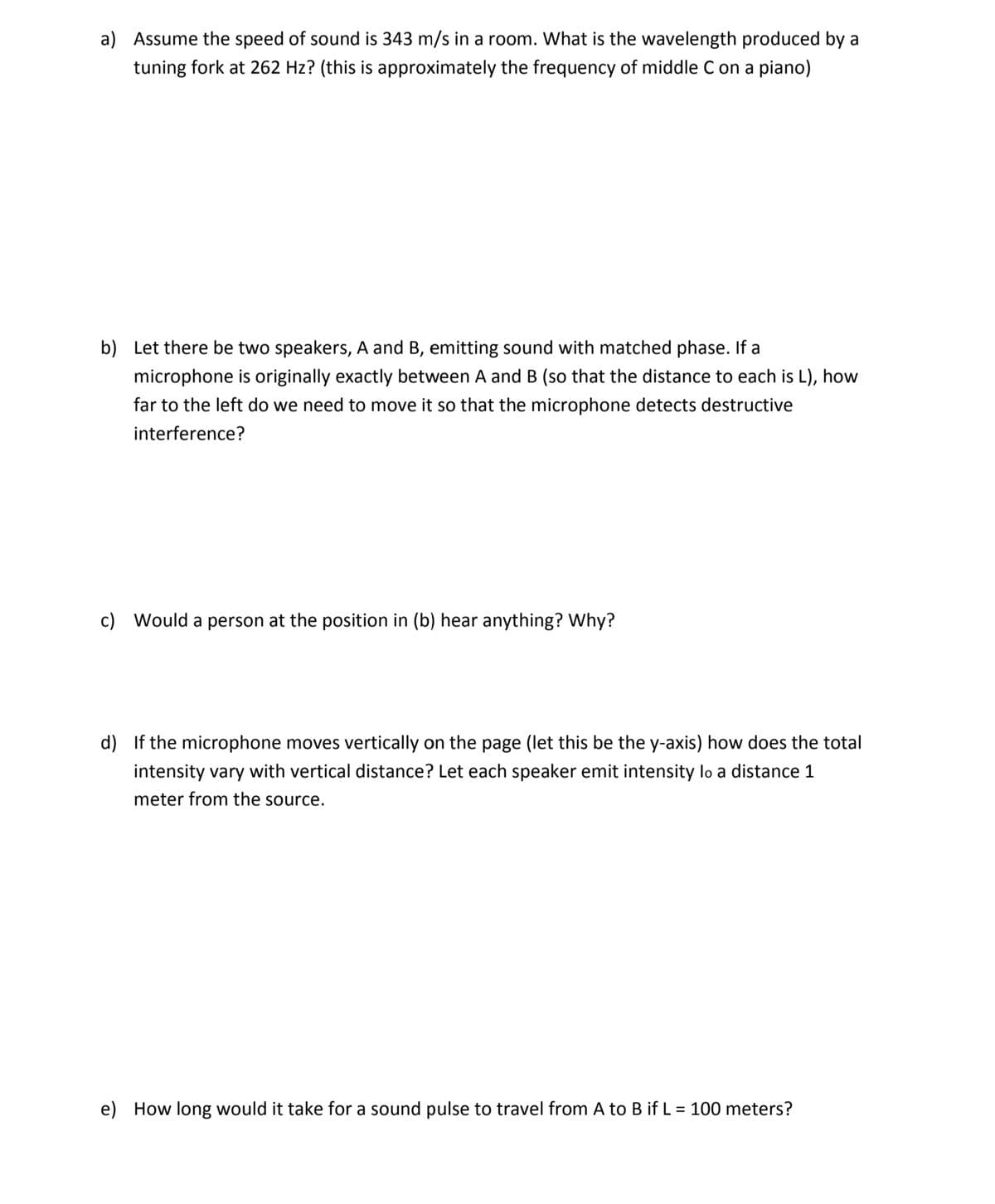a) Assume the speed of sound is 343 m/s in a room. What is the wavelength produced by a tuning fork at 262 Hz? (this is approximately the frequency of middle C on a piano)
a) Assume the speed of sound is 343 m/s in a room. What is the wavelength produced by a tuning fork at 262 Hz? (this is approximately the frequency of middle C on a piano)
Physics for Scientists and Engineers: Foundations and Connections
1st Edition
ISBN:9781133939146
Author:Katz, Debora M.
Publisher:Katz, Debora M.
Chapter18: Superposition And Standing Waves
Section: Chapter Questions
Problem 12PQ: Two speakers, facing each other and separated by a distance d, each emit a pure tone of the same...
Related questions
Question

Transcribed Image Text:a) Assume the speed of sound is 343 m/s in a room. What is the wavelength produced by a
tuning fork at 262 Hz? (this is approximately the frequency of middle C on a piano)
b) Let there be two speakers, A and B, emitting sound with matched phase. If a
microphone is originally exactly between A and B (so that the distance to each is L), how
far to the left do we need to move it so that the microphone detects destructive
interference?
c) Would a person at the position in (b) hear anything? Why?
d) If the microphone moves vertically on the page (let this be the y-axis) how does the total
intensity vary with vertical distance? Let each speaker emit intensity lo a distance 1
meter from the source.
e) How long would it take for a sound pulse to travel from A to B if L = 100 meters?
%3|
Expert Solution
This question has been solved!
Explore an expertly crafted, step-by-step solution for a thorough understanding of key concepts.
Step by step
Solved in 3 steps with 2 images

Knowledge Booster
Learn more about
Need a deep-dive on the concept behind this application? Look no further. Learn more about this topic, physics and related others by exploring similar questions and additional content below.Recommended textbooks for you

Physics for Scientists and Engineers: Foundations…
Physics
ISBN:
9781133939146
Author:
Katz, Debora M.
Publisher:
Cengage Learning

University Physics Volume 1
Physics
ISBN:
9781938168277
Author:
William Moebs, Samuel J. Ling, Jeff Sanny
Publisher:
OpenStax - Rice University

Principles of Physics: A Calculus-Based Text
Physics
ISBN:
9781133104261
Author:
Raymond A. Serway, John W. Jewett
Publisher:
Cengage Learning

Physics for Scientists and Engineers: Foundations…
Physics
ISBN:
9781133939146
Author:
Katz, Debora M.
Publisher:
Cengage Learning

University Physics Volume 1
Physics
ISBN:
9781938168277
Author:
William Moebs, Samuel J. Ling, Jeff Sanny
Publisher:
OpenStax - Rice University

Principles of Physics: A Calculus-Based Text
Physics
ISBN:
9781133104261
Author:
Raymond A. Serway, John W. Jewett
Publisher:
Cengage Learning

Classical Dynamics of Particles and Systems
Physics
ISBN:
9780534408961
Author:
Stephen T. Thornton, Jerry B. Marion
Publisher:
Cengage Learning

College Physics
Physics
ISBN:
9781938168000
Author:
Paul Peter Urone, Roger Hinrichs
Publisher:
OpenStax College

Physics for Scientists and Engineers, Technology …
Physics
ISBN:
9781305116399
Author:
Raymond A. Serway, John W. Jewett
Publisher:
Cengage Learning